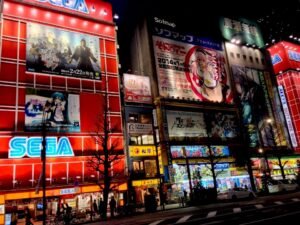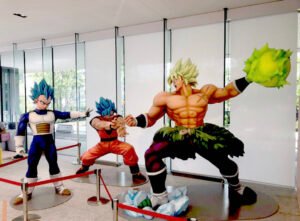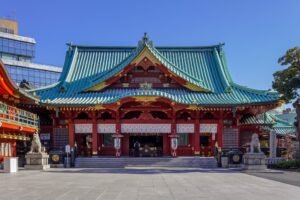Akihabara: The Anime Capital of Tokyo
All websites and information regarding Akihabara should focus on one central theme – the fact that Akihabara is the unquestionable capital of anime in Tokyo. The region in Tokyo is replete with vibrant venues and experiences, all revolving around the immense popularity of anime and manga. Akihabara contains shrines, a major shopping district for video games, anime, manga, electronics, and computer-related goods, which all showcase anime and manga icons. In addition, Akihabara boasts various historic sites that contrast beautifully with the ever-prominent electronic hotspots, making it an ideal destination for anime and history enthusiasts alike.
The area started taking shape when the shrine of Akiba, a fire-controlling deity, was destroyed by a fire in 1869. Before then, Akihabara was merely a passageway between Tokyo and northwestern Japan, which was home to craftsmen, tradesmen, and low-class samurai. After World War II, the city witnessed a rapid growth in the selling of household electronic goods, prompting the nickname, Akihabara Electronic Town.
Although anime has been an established form of entertainment since 1907, modern anime and manga have been closely intertwined since the 1960s. Anime in its modern form was first seen in 1956 and was done with the art style seen in manga. Astro Boy, the first show, was broadcasted overseas in 1963. Around the same time, Osamu Tezuka formed Mushi Productions, the first major anime production company, which became a major catalyst in the creation of contemporary shows like Dragon Ball Z and Attack on Titan.
While closely associated with anime, manga has a much more extensive history. The first manga is said to date back to the 12th century, although the art form gained popularity in the 18th century due to the western “characterization” implemented by the emperor at the time. Since then, it has been used as a part of propaganda during wars such as the Sino-Japanese War and World War I and II before evolving to complement the popularity of anime.
Electronics shoping
Akihabara is a district that boasts of various shopping centers, including the Mandarake Complex, which is situated on Akihabara Junk Street. If you are a manga lover and want to purchase in bulk, the Mandarake Complex is an ideal place for secondhand shopping, with its eight floors filled with manga, video games, and displays. The complex offers everything that a manga enthusiast could want, including doujinshi, which is fan-made manga based on actual manga stories. Typically, doujinshi consists of at least 18 installments, catering to a broad range of interests.
One of the primary reasons why Akihabara has earned the moniker of ‘Akihabara Electric Town’ is the Yodobashi Camera store. The nine-story building is one of the most extensive and finest electronic stores in Japan, offering an impressive array of gadgets and technology. A visit to this store is a must if you are in the city for at least 2-3 hours. Located just across from Akihabara Station, it provides an excellent opportunity to try the Japanese railway system.
Besides Mandarake and Yodobashi Camera stores, the Animate store on Chuo-Dori is another shopping center worth visiting. Animate is the ultimate destination for anime and otaku enthusiasts, offering an extensive collection of DVDs, souvenirs, comic books, figurines, and anime song CDs. A must-visit place for those looking to immerse themselves in anime culture.
Otaku goods
Over the course of several decades, the character of Akihabara has undergone constant changes, and this trend is ongoing. In recent times, Akihabara has transformed into a hub for Japanese otaku and anime culture. In the spaces between electronics retailers, numerous stores now specialize in anime, manga, retro video games, figurines, card games, and other collectibles.
In addition to shops, a variety of other animation-related establishments have also emerged in the area. Maid cafes, where waitresses dress up and act like maids or anime characters, have become increasingly popular, as have manga cafes (known as manga kissa), which function as internet cafes where customers can read comics, watch videos, and access the internet.
For those with a more niche interest in Japanese culture, a maid café can be a fun lunch experience. A plethora of maid cafes can be found in close proximity, each with women dressed up as maids since 2000. The waitresses (maids) at these cafes strive to interact with customers as much as possible, which has contributed to their popularity and integral role in Japanese culture. It is not uncommon to see women dressed up in maid outfits on the streets of Akihabara.
The top recommended cafes that consistently receive praise are Home Café (located on Kandamyojin-Dori Street), Cure Maid Café, and Maidreamin, each of which offers a calming mood and broad appeal. Akiba Zettai Ryoiki offers a unique twist on the maid café concept, featuring furries. This café is located near the Kamda Myojin Shrine, for those interested in this variation.
The Kanda Myojin Shrine
The shrine, which is a longstanding structure that was constructed 1,270 years ago, held significant importance to both the warrior class and citizens of the area. Over time, natural disasters and the expansion of Edo Castle have necessitated the shrine’s relocation numerous times. However, it now occupies a valuable plot of land in Tokyo. The Kanda Shrine was once primarily visited by low-class samurai from the Edo region. However, nowadays it is a popular destination for those seeking to experience the technological wonders of Akihabara. You should consider joining in on the experience! Additionally, it is highly recommended that you attend the Kanda Matsuri or Kanda festival. This festival is held on the nearest Saturday and Sunday to May 15th, but only in odd-numbered years. It is a tribute to the Kanda Shrine and draws large crowds to the streets.





